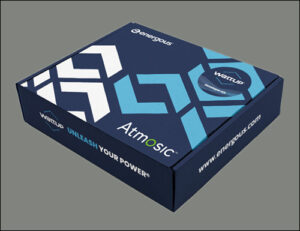Energous is selling its kit with Atmosic’s BLE system-on-chip, enabling users to build solutions that leverage wireless charging at up to a 13-meter distance for IoT solutions ranging from factory condition monitoring to in-store electronic shelf labeling.
- Removing Batteries and Wires
- Delivering BLE Data to Shoppers
- Developers Build Their Own IoT Solutions
May 10, 2022Wireless charging technology company Energous has teamed up with Atmosic to offer an evaluation kit for low-cost wireless systems leveraging battery-free Bluetooth Low Energy (BLE) beacons that can be energized via an RF transmission and then transmit data back to a server. The $500 kit includes a 1-watt WattUp PowerBridge transmitter, as well as Atmosic’s ATM3 energy-harvesting BLE system-on-chip (SoC), two energy-harvesting BLE modules, and a mobile app to build a battery-free BLE system.

Energous is selling its kit with Atmosic’s BLE system-on-chip.
The evaluation kit will enable battery-free and long-life-battery Internet of Things (IoT) applications through wireless power transfer, according to Cesar Johnston, Energous’s CEO. Energous offers over-the-air wireless power transfer solutions, along with BLE data transmission. The company expects developers to use the kit to build applications for smart building management, industrial IoT systems and retailer electronic displays.
By sending data at a long range, the system enables mobile sensor use in a wider set of applications (see Wearable Sensor Tracks Horse Health Via Wireless Charging, BLE). Its focus is on charging at a distance. The company reports transmitters charging tags at a distance of 13 meters (42.7 feet), though a deployment could offer ranges beyond that range with additional transmitters. The solution employs a 900 MHz-based, 1-watt conducted-power transmitter to provide energy to devices that can include IoT devices. The company was launched nine years ago to provide both contact- and distance-based power, but its development has recently targeted the distance-power sector.
The WattUp PowerBridge transmitter that Energous developed has achieved regulatory certification in the United States, the European Union, China and India, the company says. Its certifications have been growing throughout the past six months, the firm notes, especially in the Internet of Things sector.
Removing Batteries and Wires
The benefits of wireless, battery-free technology are multifold, according to the company. Labels can be less expensive to operate without batteries, and battery replacements do not need to be provided by retailer staff members. Such technology also reduces the volume of spent batteries that end up in the waste stream, Energous reports.
Energous’s transmitter can power a wide variety of electronic devices beyond BLE tags, the company reports. “We’re looking at an ecosystem where we will charge not just our tags, but any other potential devices that will benefit from this power,” Johnston says. The end goal, he adds, is to effectively remove wires and batteries. “That’s the vision. That’s where we’re going right now.”

Cesar Johnston
Standard BLE systems require batteries to transmit to mobile phones or other devices. That means BLE-enabled labels in stores, for instance, require an onboard power source. Passive RFID tags would not require batteries, but they would need to be interrogated by an RFID reader, such as a handheld device, in order to respond. Such passive RFID devices typically do not collect sensor data, due to the lack of power.
Energous has been working with Wiliot, leveraging that company’s battery-free IoT Pixel BLE tags, which can operate with over-the-air power. The Wiliot tags receive power from the Energous device, then beacon a unique ID number to receiving devices. Such receivers could be Bluetooth-enabled access points, smartphones or dedicated beacon devices.
To power a device wirelessly at a distance, the WattUp transmitter currently transmits power via 900 MHz transmissions, enabling a longer range and higher wattage to be sent than at other higher frequencies, within regulatory restrictions. The company also offers 5-watt and 10-watt transmission solutions. The earliest transmitter deployments include applications to power electronic shelf labels and other IoT sensor devices which transmit and receive BLE data. This can include data about temperature or moisture conditions, for instance, for maintenance purposes.
Delivering BLE Data to Shoppers
Electronic shelf labels could display a price and related information transmitted to it by a BLE device. Such labels could also enable engagement with shoppers. For instance, customers who opt into a loyalty program could be identified based on their phone’s unique ID, and their location could be pinpointed based on their proximity to an ESL. If they approach a label for merchandise they frequently buy, the system could identify that action and send an invitation to the shopper’s phone via the store’s app, offering a discount on that product.
Such applications are made more affordable for stores with the battery-free power options, so that low-cost labels could be mounted on shelves in the hundreds or thousands. The technology can also enable sensors to alert users regarding conditions in an industrial setting, such as any leak around a piece of equipment. The sensor devices could leverage the wireless power transmission to collect sensor data, then transmit an alert if a reading such as moisture detection occurs.
By offering the wireless technology, Johnston says, and by building greater transmission power and distance, “What we’re doing here is very similar to what was done in the early days when people were deploying Wi-Fi.” While the system is being launched with 1-watt transmission capacity, he adds, that is expected to grow, just as bandwidth for Wi-Fi data has increased to accommodate the greater demand.
The solution could work with edge-based artificial intelligence (AI) as well, the company reports, with sufficient power delivered to IoT devices that they would be able to perform simple computing and accomplish more data processing, thereby reducing the amount of data that would need to be sent to the cloud. In January 2022, Energous demonstrated its technology at the Consumer Electronics Show with Juniper Networks‘ AI-based Juniper Mist Wi-Fi hardware.
Developers Build Their Own IoT Solutions
Johnston says the kit is currently being sampled by developers interested in building systems for industrial IoT or shelf labels. The kit’s sensor modules come with temperature, humidity and acceleration reading capability. “There are more and more people that are just wanting to experiment,” he states. “This is a new technology, so people are learning. But one way for them to learn and see that it works is to actually use this evaluation kit to start developing their own products.”
The collected sensor data can be used with smart-home or smart-building applications, by capturing data about the conditions within rooms or buildings, for use by property owners, managers or tenants. As IoT solutions proliferate, Johnston predicts a greater number of developers will seek wireless power. The company intends to continue pushing power levels to 5 watts or more in the future. The evaluation kit will be made available for $500 from both Atmosic and Energous, starting in the second quarter of this year.
Key Takeaways:
- RF-based wireless power could enable low-cost IoT deployments using battery-free BLE tags or sensors.
- The developer kit is aimed at providing tools needed to experiment with and build solutions for a wide variety of applications.
Exhibitors at RFID Journal LIVE! 2022 will offer IoT-based solutions for power-harvesting applications. To learn more, visit the event’s website.
See the original article here: <CLICK ME>
